lock DODGE STRATUS COUPE 2004 2.G Workshop Manual
[x] Cancel search | Manufacturer: DODGE, Model Year: 2004, Model line: STRATUS COUPE, Model: DODGE STRATUS COUPE 2004 2.GPages: 388, PDF Size: 2.28 MB
Page 68 of 388
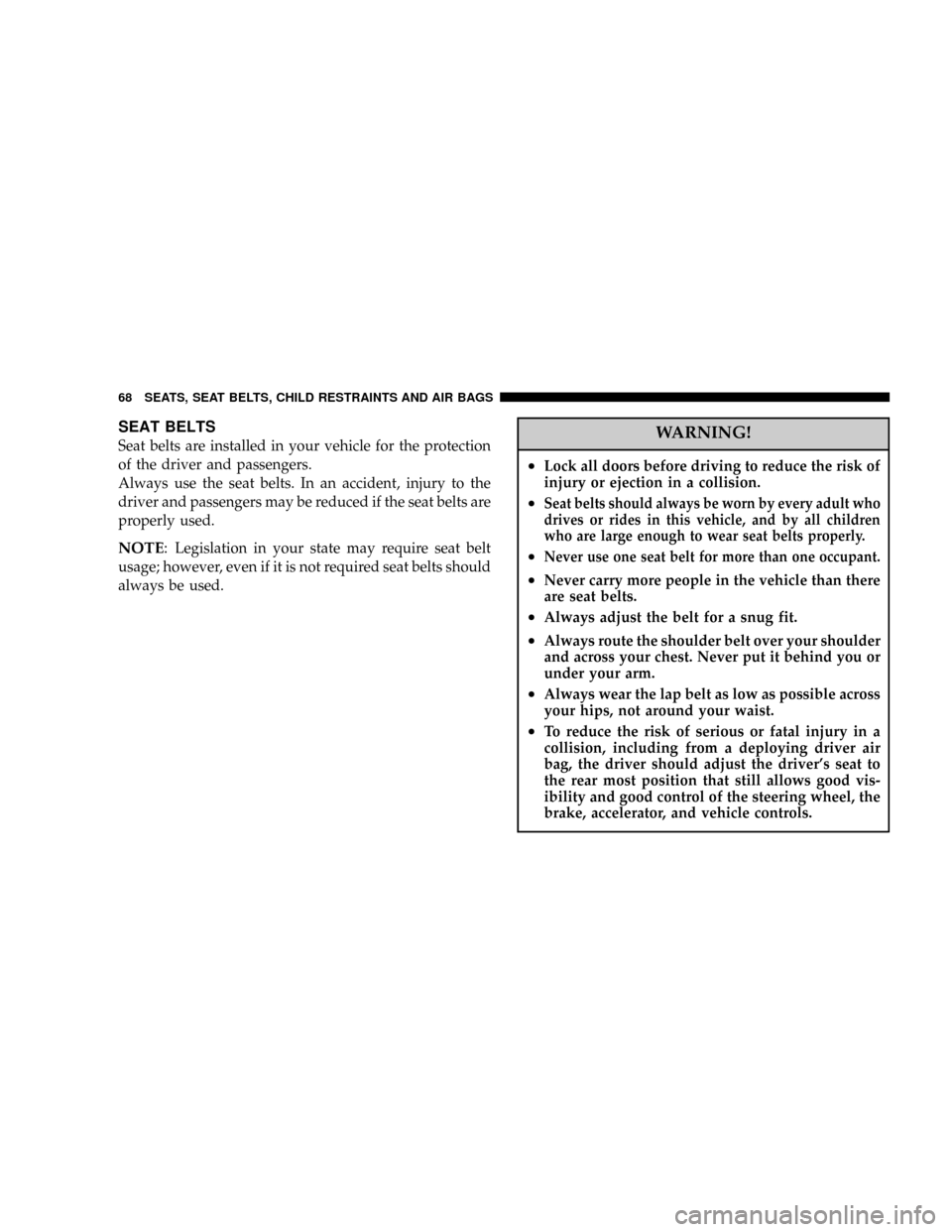
SEAT BELTS
Seat belts are installed in your vehicle for the protection
of the driver and passengers.
Always use the seat belts. In an accident, injury to the
driver and passengers may be reduced if the seat belts are
properly used.
NOTE: Legislation in your state may require seat belt
usage; however, even if it is not required seat belts should
always be used.
WARNING!
²Lock all doors before driving to reduce the risk of
injury or ejection in a collision.
²Seat belts should always be worn by every adult who
drives or rides in this vehicle, and by all children
who are large enough to wear seat belts properly.
²Never use one seat belt for more than one occupant.
²Never carry more people in the vehicle than there
are seat belts.
²Always adjust the belt for a snug fit.
²Always route the shoulder belt over your shoulder
and across your chest. Never put it behind you or
under your arm.
²Always wear the lap belt as low as possible across
your hips, not around your waist.
²To reduce the risk of serious or fatal injury in a
collision, including from a deploying driver air
bag, the driver should adjust the driver's seat to
the rear most position that still allows good vis-
ibility and good control of the steering wheel, the
brake, accelerator, and vehicle controls.
68 SEATS, SEAT BELTS, CHILD RESTRAINTS AND AIR BAGS
Page 69 of 388
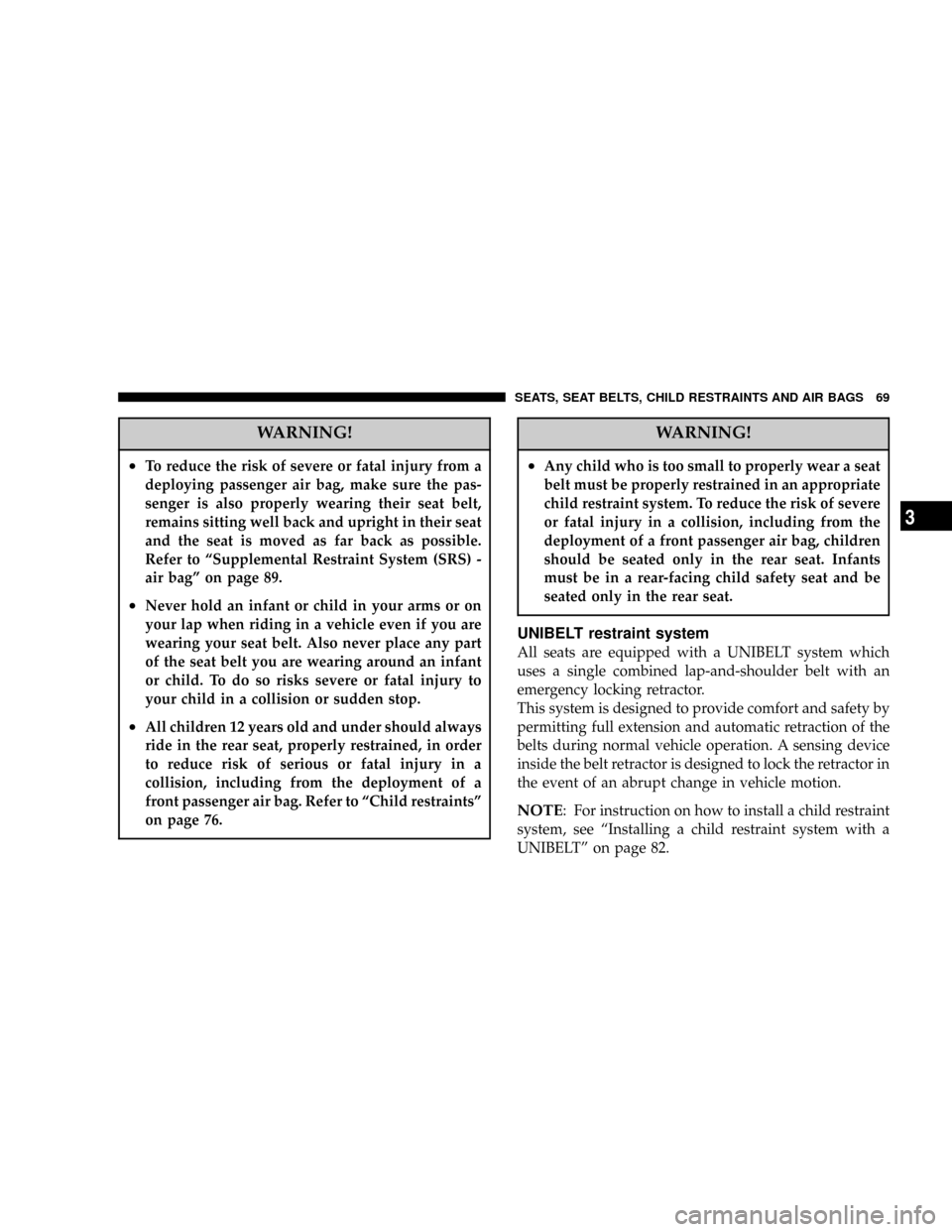
WARNING!
²To reduce the risk of severe or fatal injury from a
deploying passenger air bag, make sure the pas-
senger is also properly wearing their seat belt,
remains sitting well back and upright in their seat
and the seat is moved as far back as possible.
Refer to ªSupplemental Restraint System (SRS) -
air bagº on page 89.
²Never hold an infant or child in your arms or on
your lap when riding in a vehicle even if you are
wearing your seat belt. Also never place any part
of the seat belt you are wearing around an infant
or child. To do so risks severe or fatal injury to
your child in a collision or sudden stop.
²All children 12 years old and under should always
ride in the rear seat, properly restrained, in order
to reduce risk of serious or fatal injury in a
collision, including from the deployment of a
front passenger air bag. Refer to ªChild restraintsº
on page 76.
WARNING!
²Any child who is too small to properly wear a seat
belt must be properly restrained in an appropriate
child restraint system. To reduce the risk of severe
or fatal injury in a collision, including from the
deployment of a front passenger air bag, children
should be seated only in the rear seat. Infants
must be in a rear-facing child safety seat and be
seated only in the rear seat.
UNIBELT restraint system
All seats are equipped with a UNIBELT system which
uses a single combined lap-and-shoulder belt with an
emergency locking retractor.
This system is designed to provide comfort and safety by
permitting full extension and automatic retraction of the
belts during normal vehicle operation. A sensing device
inside the belt retractor is designed to lock the retractor in
the event of an abrupt change in vehicle motion.
NOTE: For instruction on how to install a child restraint
system, see ªInstalling a child restraint system with a
UNIBELTº on page 82.
SEATS, SEAT BELTS, CHILD RESTRAINTS AND AIR BAGS 69
3
Page 71 of 388
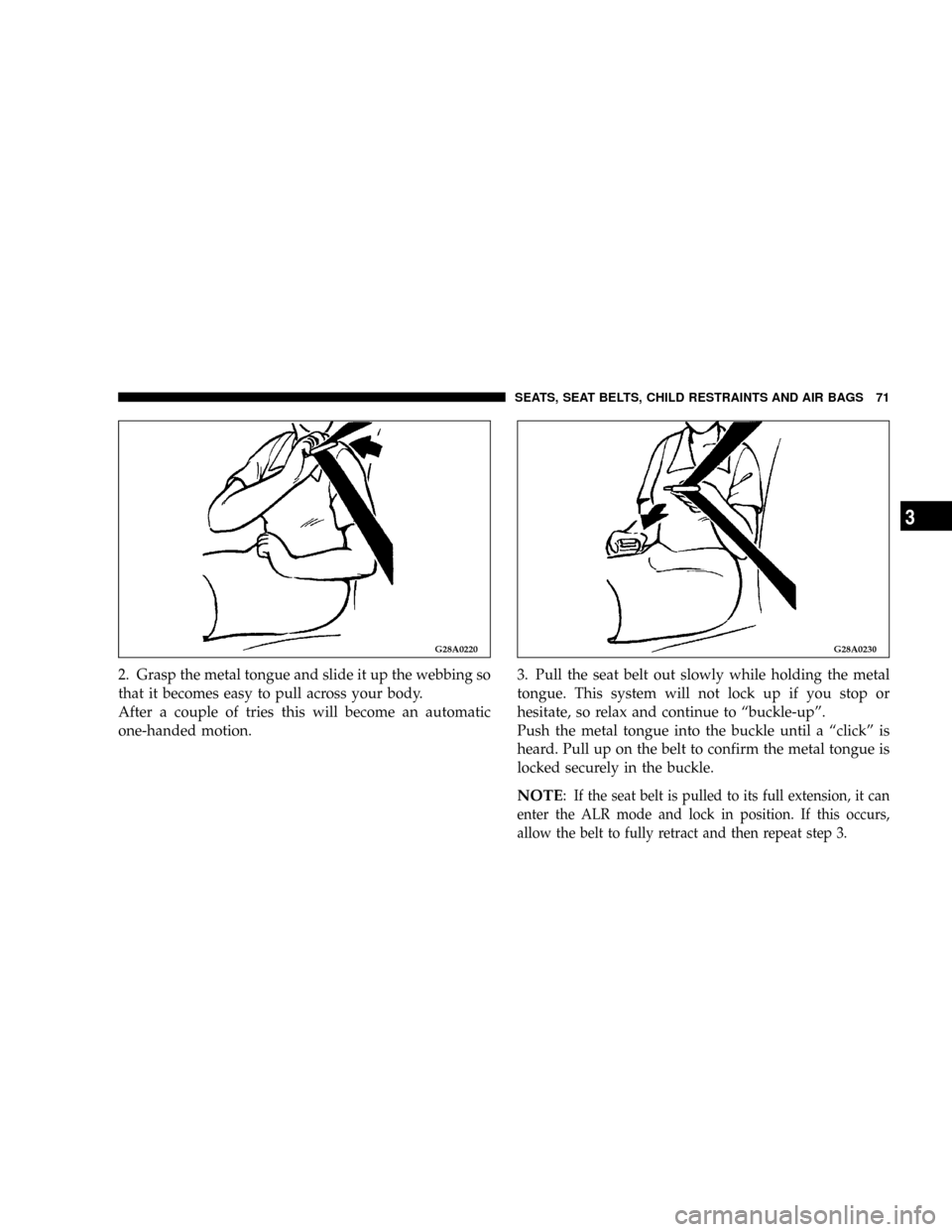
2. Grasp the metal tongue and slide it up the webbing so
that it becomes easy to pull across your body.
After a couple of tries this will become an automatic
one-handed motion.3. Pull the seat belt out slowly while holding the metal
tongue. This system will not lock up if you stop or
hesitate, so relax and continue to ªbuckle-upº.
Push the metal tongue into the buckle until a ªclickº is
heard. Pull up on the belt to confirm the metal tongue is
locked securely in the buckle.
NOTE:If the seat belt is pulled to its full extension, it can
enter the ALR mode and lock in position. If this occurs,
allow the belt to fully retract and then repeat step 3.
G28A0220G28A0230
SEATS, SEAT BELTS, CHILD RESTRAINTS AND AIR BAGS 71
3
Page 72 of 388

4. Pull up on the shoulder portion of the belt to ensure
that there is no slack in the lap belt. The belt will retain
the small amount of slack necessary for comfort when
you return to your normal seating position. If the belt is
still too tight, pull out 6 to 8 inches of webbing, release
the belt, and let it return to your chest.
NOTE: If a person wearing the seat belt moves their
upper body or the belt completely unwinds, the retractor
may switch to its Automatic Locking Retractor (ALR)
child restraint installation mode and lock (see page 82),
thus preventing further movement. If this happens, the
person should switch the retractor back to its Emergency
Locking Retractor (ELR) mode by unlatching the buckle
and letting the belt fully retract. The person should then
put the seat belt back on repeating steps 1 through 4.
WARNING!
²Be sure the lap belt portion fits snugly and as low
as possible across the hips, not around the waist.
Failure to do so may increase the chance or sever-
ity of injury in the event of a collision.
²Wear the seat belt without twisting it.
G28A0240
72 SEATS, SEAT BELTS, CHILD RESTRAINTS AND AIR BAGS
Page 73 of 388
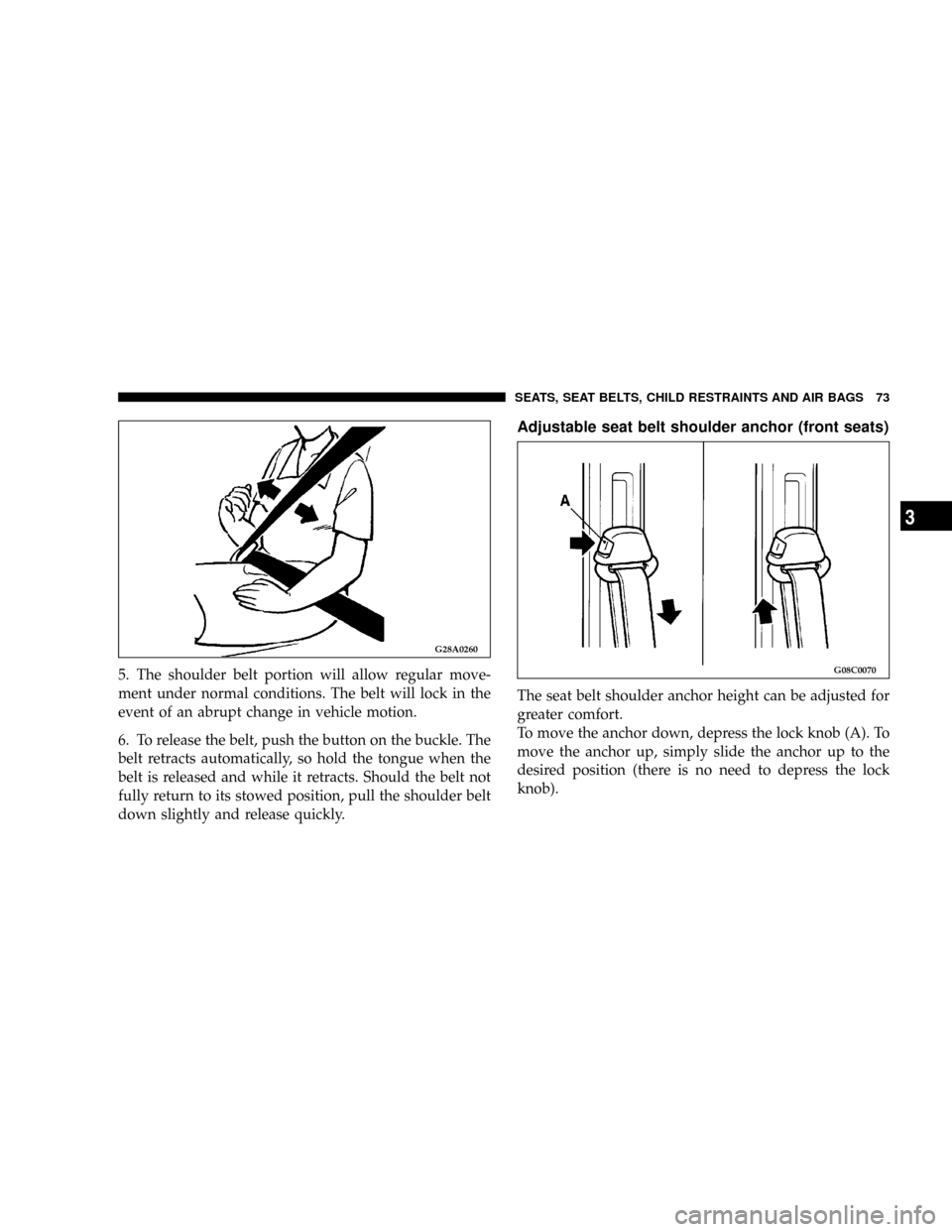
5. The shoulder belt portion will allow regular move-
ment under normal conditions. The belt will lock in the
event of an abrupt change in vehicle motion.
6. To release the belt, push the button on the buckle. The
belt retracts automatically, so hold the tongue when the
belt is released and while it retracts. Should the belt not
fully return to its stowed position, pull the shoulder belt
down slightly and release quickly.
Adjustable seat belt shoulder anchor (front seats)
The seat belt shoulder anchor height can be adjusted for
greater comfort.
To move the anchor down, depress the lock knob (A). To
move the anchor up, simply slide the anchor up to the
desired position (there is no need to depress the lock
knob).
G28A0260
G08C0070
SEATS, SEAT BELTS, CHILD RESTRAINTS AND AIR BAGS 73
3
Page 76 of 388
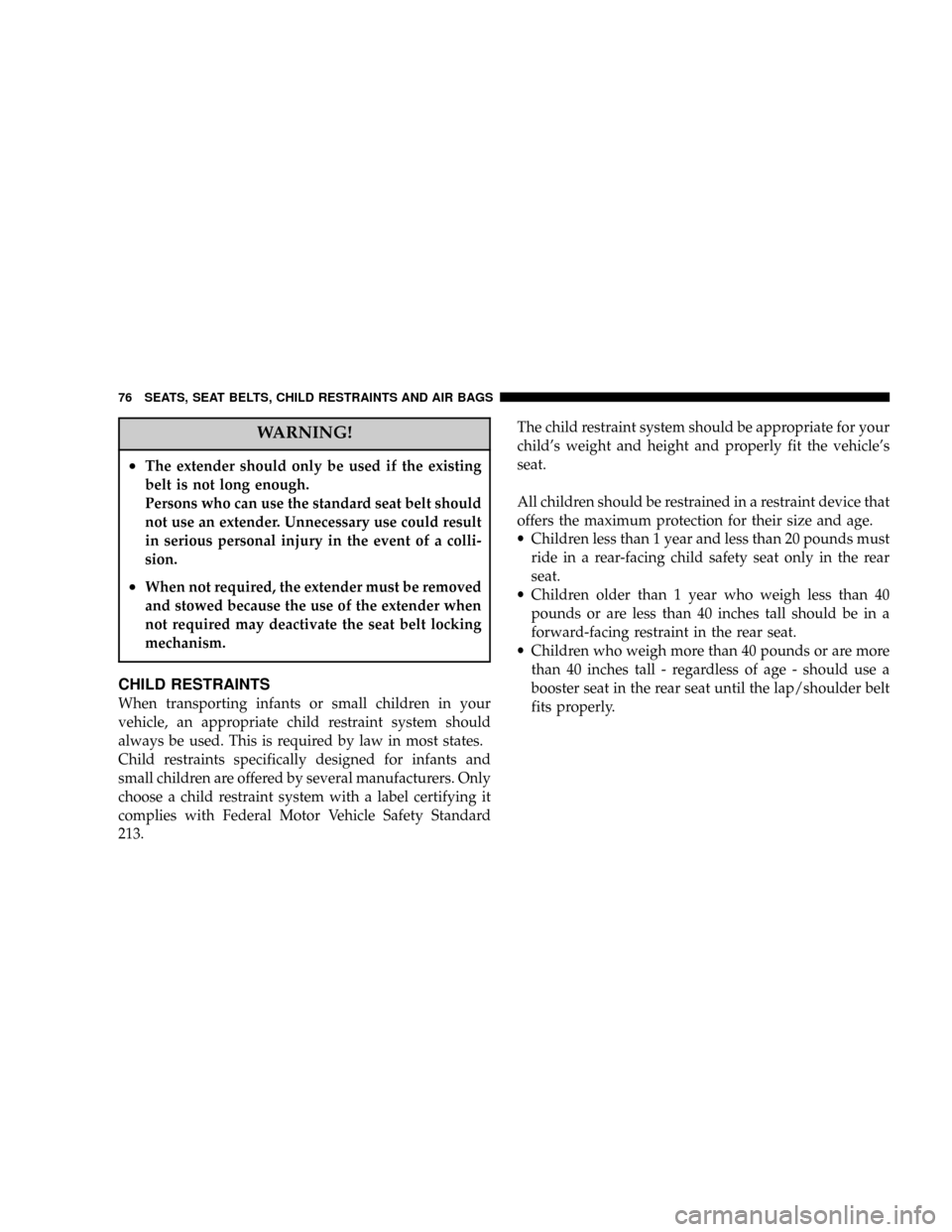
WARNING!
²The extender should only be used if the existing
belt is not long enough.
Persons who can use the standard seat belt should
not use an extender. Unnecessary use could result
in serious personal injury in the event of a colli-
sion.
²When not required, the extender must be removed
and stowed because the use of the extender when
not required may deactivate the seat belt locking
mechanism.
CHILD RESTRAINTS
When transporting infants or small children in your
vehicle, an appropriate child restraint system should
always be used. This is required by law in most states.
Child restraints specifically designed for infants and
small children are offered by several manufacturers. Only
choose a child restraint system with a label certifying it
complies with Federal Motor Vehicle Safety Standard
213.The child restraint system should be appropriate for your
child's weight and height and properly fit the vehicle's
seat.
All children should be restrained in a restraint device that
offers the maximum protection for their size and age.
·Children less than 1 year and less than 20 pounds must
ride in a rear-facing child safety seat only in the rear
seat.
·Children older than 1 year who weigh less than 40
pounds or are less than 40 inches tall should be in a
forward-facing restraint in the rear seat.
·Children who weigh more than 40 pounds or are more
than 40 inches tall - regardless of age - should use a
booster seat in the rear seat until the lap/shoulder belt
fits properly.
76 SEATS, SEAT BELTS, CHILD RESTRAINTS AND AIR BAGS
Page 82 of 388
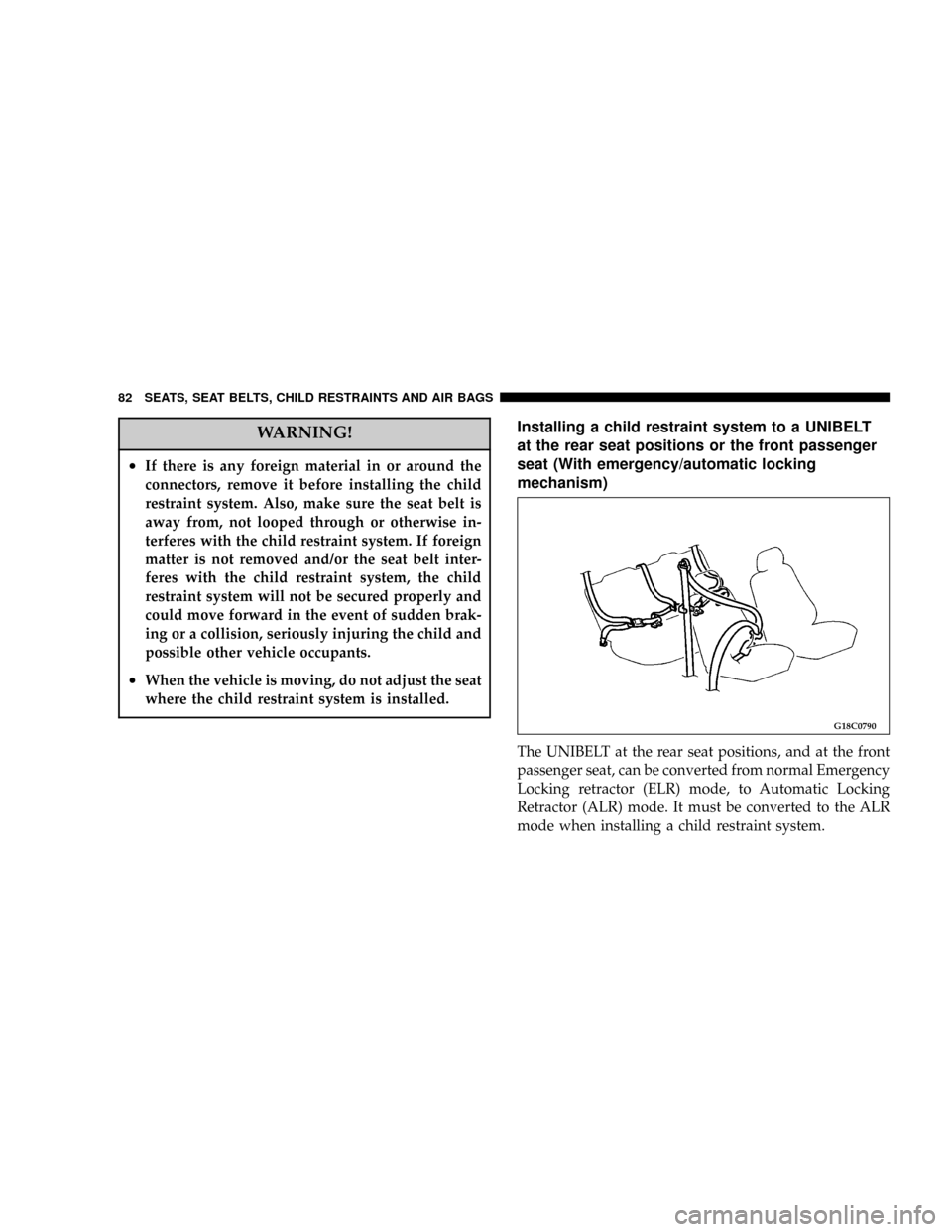
WARNING!
²If there is any foreign material in or around the
connectors, remove it before installing the child
restraint system. Also, make sure the seat belt is
away from, not looped through or otherwise in-
terferes with the child restraint system. If foreign
matter is not removed and/or the seat belt inter-
feres with the child restraint system, the child
restraint system will not be secured properly and
could move forward in the event of sudden brak-
ing or a collision, seriously injuring the child and
possible other vehicle occupants.
²When the vehicle is moving, do not adjust the seat
where the child restraint system is installed.
Installing a child restraint system to a UNIBELT
at the rear seat positions or the front passenger
seat (With emergency/automatic locking
mechanism)
The UNIBELT at the rear seat positions, and at the front
passenger seat, can be converted from normal Emergency
Locking retractor (ELR) mode, to Automatic Locking
Retractor (ALR) mode. It must be converted to the ALR
mode when installing a child restraint system.
G18C0790
82 SEATS, SEAT BELTS, CHILD RESTRAINTS AND AIR BAGS
Page 84 of 388
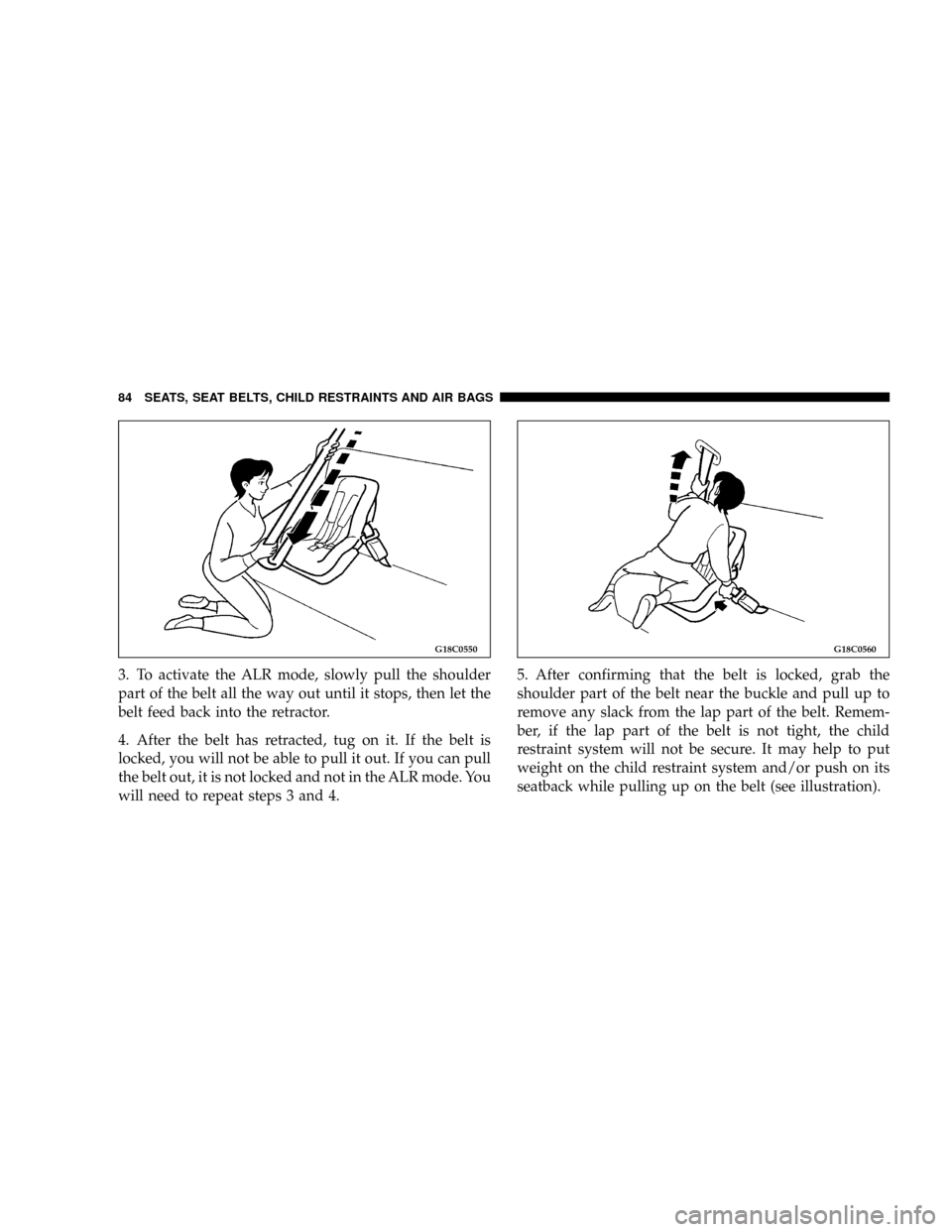
3. To activate the ALR mode, slowly pull the shoulder
part of the belt all the way out until it stops, then let the
belt feed back into the retractor.
4. After the belt has retracted, tug on it. If the belt is
locked, you will not be able to pull it out. If you can pull
the belt out, it is not locked and not in the ALR mode. You
will need to repeat steps 3 and 4.5. After confirming that the belt is locked, grab the
shoulder part of the belt near the buckle and pull up to
remove any slack from the lap part of the belt. Remem-
ber, if the lap part of the belt is not tight, the child
restraint system will not be secure. It may help to put
weight on the child restraint system and/or push on its
seatback while pulling up on the belt (see illustration).
G18C0550G18C0560
84 SEATS, SEAT BELTS, CHILD RESTRAINTS AND AIR BAGS
Page 87 of 388
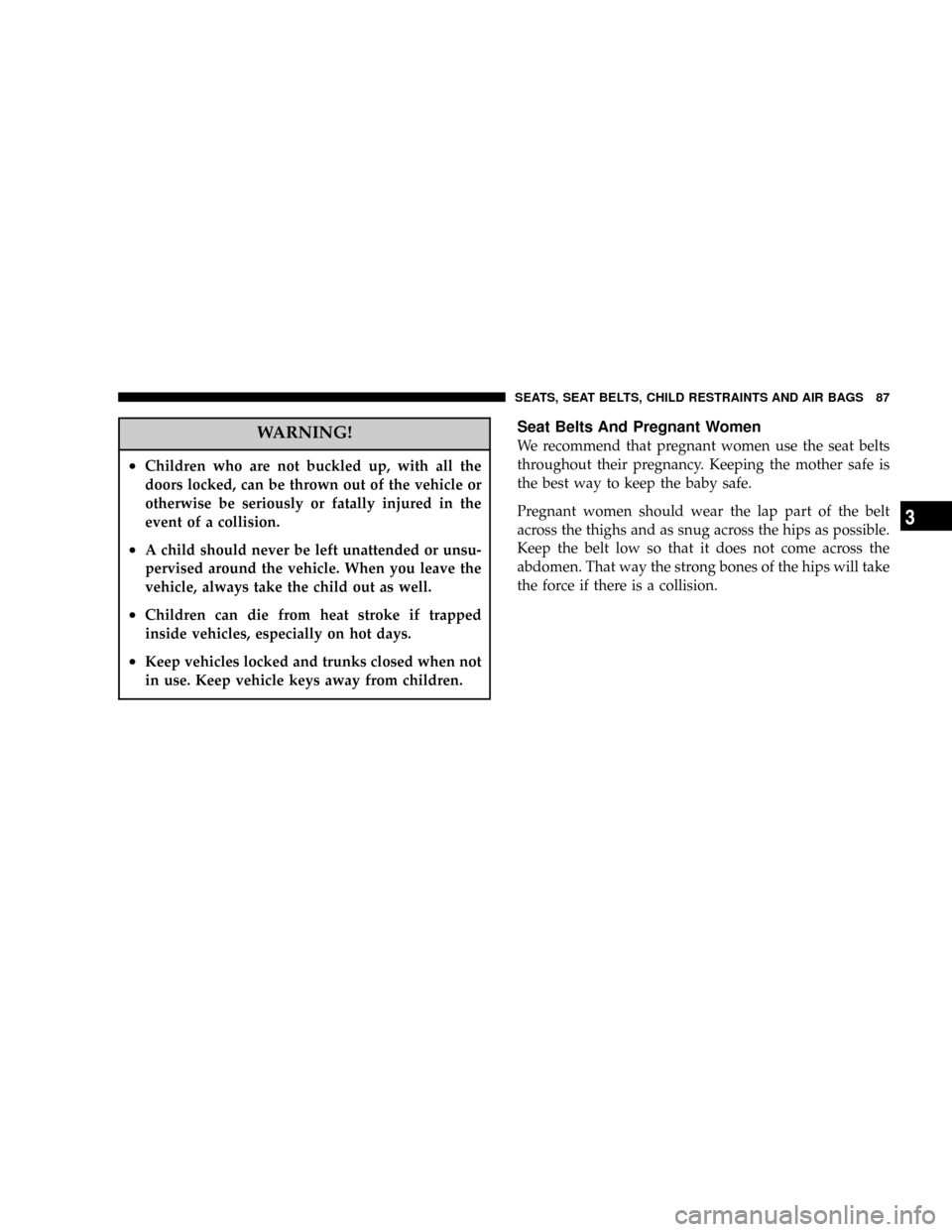
WARNING!
²Children who are not buckled up, with all the
doors locked, can be thrown out of the vehicle or
otherwise be seriously or fatally injured in the
event of a collision.
²A child should never be left unattended or unsu-
pervised around the vehicle. When you leave the
vehicle, always take the child out as well.
²Children can die from heat stroke if trapped
inside vehicles, especially on hot days.
²Keep vehicles locked and trunks closed when not
in use. Keep vehicle keys away from children.
Seat Belts And Pregnant Women
We recommend that pregnant women use the seat belts
throughout their pregnancy. Keeping the mother safe is
the best way to keep the baby safe.
Pregnant women should wear the lap part of the belt
across the thighs and as snug across the hips as possible.
Keep the belt low so that it does not come across the
abdomen. That way the strong bones of the hips will take
the force if there is a collision.
SEATS, SEAT BELTS, CHILD RESTRAINTS AND AIR BAGS 87
3
Page 88 of 388
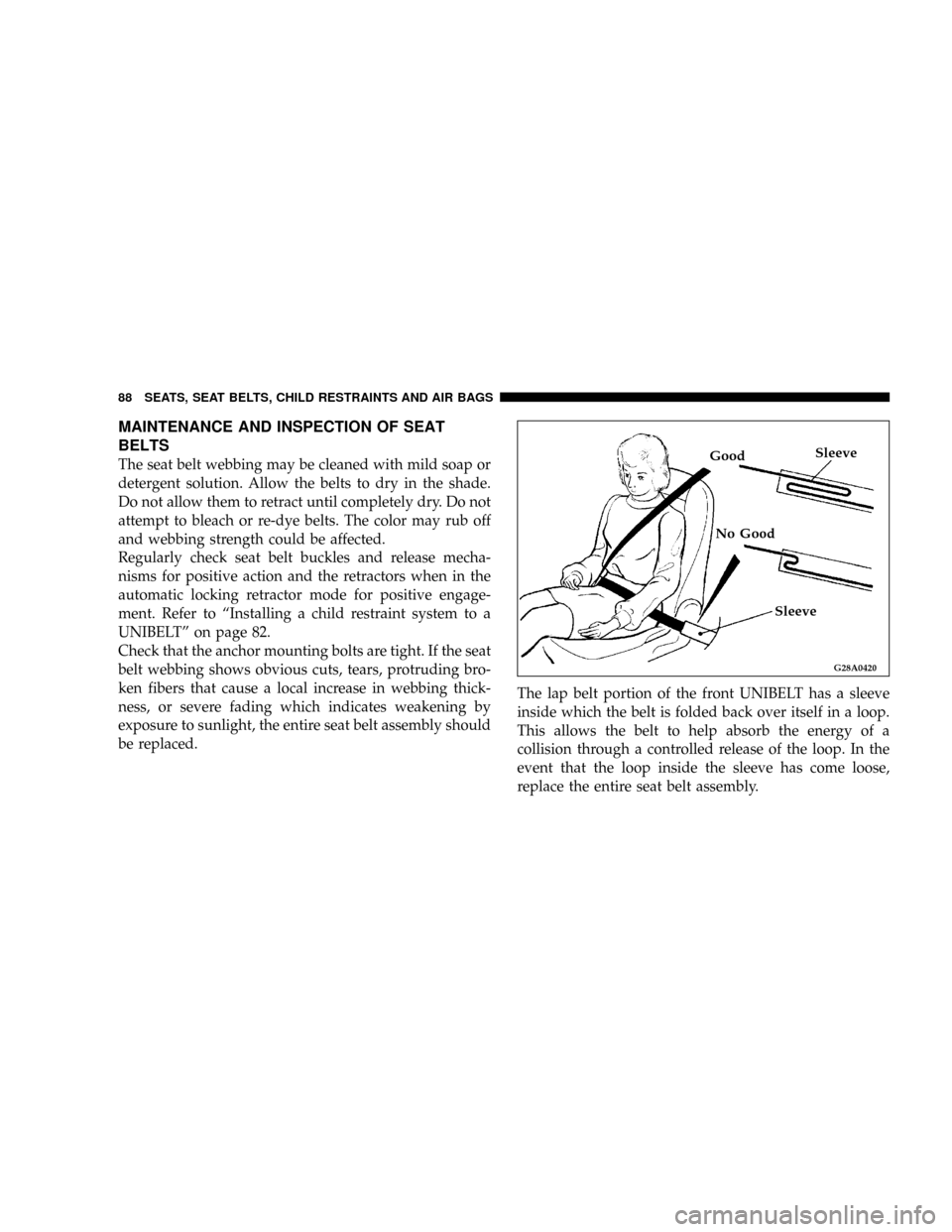
MAINTENANCE AND INSPECTION OF SEAT
BELTS
The seat belt webbing may be cleaned with mild soap or
detergent solution. Allow the belts to dry in the shade.
Do not allow them to retract until completely dry. Do not
attempt to bleach or re-dye belts. The color may rub off
and webbing strength could be affected.
Regularly check seat belt buckles and release mecha-
nisms for positive action and the retractors when in the
automatic locking retractor mode for positive engage-
ment. Refer to ªInstalling a child restraint system to a
UNIBELTº on page 82.
Check that the anchor mounting bolts are tight. If the seat
belt webbing shows obvious cuts, tears, protruding bro-
ken fibers that cause a local increase in webbing thick-
ness, or severe fading which indicates weakening by
exposure to sunlight, the entire seat belt assembly should
be replaced.The lap belt portion of the front UNIBELT has a sleeve
inside which the belt is folded back over itself in a loop.
This allows the belt to help absorb the energy of a
collision through a controlled release of the loop. In the
event that the loop inside the sleeve has come loose,
replace the entire seat belt assembly.
G28A0420
Good
No GoodSleeve
Sleeve
88 SEATS, SEAT BELTS, CHILD RESTRAINTS AND AIR BAGS